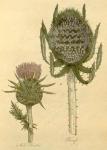A very beautiful plant, common by road sides, but wanting only to have been a native of Greece, or the Indies, to be esteemed one of the most elegant vegetables in the world. The leaves rising from the root are two feet long, and more than a foot broad, of a beautiful deep green, variegated ail over with irregular lines of a milk white, dentated deeply at the edges, and prickly. They spread themselves into a round of more than a yard diameter, and when they grow out of the way of dust, make a most charming appearance. A single stalk rises in the midst of these. It is five feet high, round, thick, very firm, upright, and divided at the top into a few branches. The leaves on it are like those from the root, and variegated with white in the same manner. At the tops stand the flowers, which are of the nature of those of other thistles, but twice as big, and vastly more beautiful. The flowery part is of a deep and fine purple; the head itself is composed of beautiful scales arranged with great regularity, and each terminating in a single and very strong prickle; the root is long and thick; the seeds are winged with down.
The root and seeds are used. An infusion of the fresh root removes obstructions, and works by urine; it is good against the jaundice. The seeds beaten up into an emulsion with barley-water are good in pleurisies. The young leaves with the prickles cut off, are excellent boiled in the way of cabbage; they are very wholesome, and exceed all other greens in taste.


